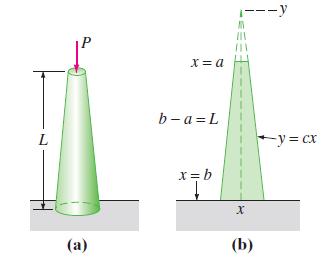In Example 4 of Section 5.2 we saw that when a constant vertical compressive force or load
Question:
In Example 4 of Section 5.2 we saw that when a constant vertical compressive force or load P was applied to a thin column of uniform cross section, the deflection y(x) was a solution of the boundary-value problem

The assumption here is that the column is hinged at both ends. The column will buckle or deflect only when the compressive force is a critical load Pn.
(a) In this problem let us assume that the column is of length L, is hinged at both ends, has circular cross sections, and is tapered as shown in Figure 6.3.1(a). If the column, a truncated cone, has a linear taper y = cx as shown in cross section in Figure 6.3.1(b), the moment of inertia of a cross section with respect to an axis perpendicular to the xy-plane is I = ¼ πr4, where r = y and y = cx. Hence we can write I(x) = I0(x/b)4, where I0 = I(b) = 1/4π(cb)4 Substituting I(x) into the differential equation in (24), we see that the deflection in this case is determined from the BVP

where λ = Pb4 EI0. Use the results of Problem 33 to find the critical loads Pn for the tapered column. Use an appropriate identity to express the buckling modes yn(x) as a single function.
(b) Use a CAS to plot the graph of the first buckling mode y1(x) corresponding to the Euler load P1 when b = 11 and a = 1.

Step by Step Answer:

A First Course in Differential Equations with Modeling Applications
ISBN: 978-1111827052
10th edition
Authors: Dennis G. Zill




